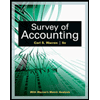
1.
Bonds: Bonds are long-term promissory notes that are represented by a company while borrowing money from investors to raise fund for financing the operations.
Common stock: It refers to a security issued in a form of certificate and implies the right of ownership of an investor over a portion of company’s earnings and assets.
Earnings per Share: It is a portion of profit that is earned by each common stock.
Formula:
To Determine: Earnings per share of common stock for each plan, if income before bond interest and income tax is $2,100,000.
1.
Explanation of Solution
Determine Earnings per share of common stock.
| Particulars | Plan 1 | Plan 2 | Plan 3 |
| Net income before interest on bonds and income tax | $2,100,000 | $2,100,000 | $2,100,000 |
| Less: Interest on bonds | - | - | $720,000(1) |
| Income before income tax | $2,100,000 | $2,100,000 | $1,380,000 |
| Less: Income tax expense | $840,000(2) | $840,000(2) | $552,000(3) |
| Net income | $1,260,000 | $1,260,000 | $828,000 |
|
Dividends on | - | $360,000(4) | $180,000(5) |
| Available for dividends on common stock | $1,260,000 | $900,000 | $648,000 |
| Number of common stock outstanding |
|
|
|
| Earnings per share of common stock | $0.70 | $1.00 | $1.44 |
Table (1)
Working notes:
Calculate interest on bonds for plan 3.
Calculate income tax expense for plan 1 and plan 2.
Calculate income tax expense for plan 3.
Calculate dividends on preferred stock for plan 2.
Calculate dividends on preferred stock for plan 3.
Calculate Number of common stock outstanding for Plan 1.
Calculate Number of common stock outstanding for Plan 2.
Calculate Number of common stock outstanding for Plan 3.
2.
Earnings per share of common stock for each plan, if income before bond interest and income tax is $1,050,000.
2.
Explanation of Solution
Determine Earnings per share of common stock.
| Particulars | Plan 1 | Plan 2 | Plan 3 |
| Net income before interest on bonds and income tax | $1,050,000 | $1,050,000 | $1,050,000 |
| Less: Interest on bonds | - | - | $720,000(1) |
| Income before income tax | $1,050,000 | $1,050,000 | $330,000 |
| Less: Income tax expense | $420,000(9) | $420,000(9) | $132,000(10) |
| Net income | $630,000 | $630,000 | $198,000 |
| Dividends on preferred stock | - | $360,000(4) | $180,000(5) |
| Available for dividends on common stock | $630,000 | $270,000 | $18,000 |
| Number of common stock outstanding |
|
|
|
| Earnings per share of common stock | $0.35 | $0.30 | $0.04 |
Table (2)
Working notes:
Calculate income tax expense for plan 1 and plan 2.
Calculate income tax expense for plan 3.
3.
To describe: The advantages and disadvantages of each plans.
3.
Explanation of Solution
The following are the advantages and disadvantages of Plan 1:
Advantages:
- It involves only in the issuance of common stock. Hence, it does not require to pay periodic interest payment, return on principal, and payment of preferred dividends.
- In case, when earnings before interest and income tax is $1,050,000, Plan 1 is more attractive to common shareholders than Plan 2 and Plan 3 because it has largest EPS ($0.35).
Disadvantage:
- In case, when earnings before interest and income tax is $2,100,000, Plan 1 is less attractive to common shareholders than Plan 2 and Plan 3 because it offers the lowest EPS ($0.70).
The following is the advantages and disadvantages of Plan 2:
Advantage:
- It involves only in the issuance of common stock and preferred stock. Hence, it does not require to pay periodic interest payment, return on principal.
- In both cases, when earnings before interest and income tax is $2,100,000 and $1,050,000, Plan 2 is moderate attractive to common shareholders than Plan 1 and Plan 3 because it provides medium EPS ($1.00) and ($0.30).
Disadvantage:
- In plan 2, it required to pay preferred dividends before common dividends.
The following is the advantages and disadvantages of Plan 3:
Advantage:
- In case, when earnings before interest and income tax is $2,100,000, Plan 3 is more attractive to common shareholders than Plan 1 and Plan 2 because it offers the largest EPS ($1.44).
Disadvantages:
- In case, when earnings before interest and income tax is $1,050,000, Plan 3 is less attractive to common shareholders than Plan 1 and Plan 2 because it provides lowest EPS ($0.04).
- It involves in the issuance of bonds, common stock and preferred stock. Hence, it is required to pay periodic interest payment, principal payment, and also required to pay preferred dividends before common dividends
Want to see more full solutions like this?
Chapter 14 Solutions
ACCOUNTING (LOOSELEAF)-W/STD.GDE+ACCESS
- I need help finding the accurate solution to this general accounting problem with valid methods.arrow_forwardin the “Problems – Series A” section 8-19A of Ch. 8, “Performance Evaluation” of Fundamentals of Managerial Accounting Concepts. Scenario: The Redmond Management Association held its annual public relations luncheon in April Year 2. Based on the previous year’s results, the organization allocated $25,290 of its operating budget to cover the cost of the luncheon. To ensure that costs would be appropriately controlled, you, the treasurer, prepared the following budget for the Year 2 luncheon. Usin Excel—showing all work and formulas—to complete the following: I need help Preparing a flexible budget. Computing the sales volume variance and the variable cost volume variances based on a comparison between the master budget and the flexible budget. And Computing flexible budget variances by comparing the flexible budget with the actual results.arrow_forwardI am searching for the accurate solution to this financial accounting problem with the right approach.arrow_forward
- Cher Enterprises reported net income of $2,100,000. The average total liabilities were $6,800,000 and the average total stockholders' equity was $7,400,000. Interest expense was $250,000 and the tax rate was 30%. What is the return on assets ratio?arrow_forwardThe manufacturing overhead is_.arrow_forwardCan you explain this general accounting question using accurate calculation methods?arrow_forward
 Survey of Accounting (Accounting I)AccountingISBN:9781305961883Author:Carl WarrenPublisher:Cengage Learning
Survey of Accounting (Accounting I)AccountingISBN:9781305961883Author:Carl WarrenPublisher:Cengage Learning Financial Accounting: The Impact on Decision Make...AccountingISBN:9781305654174Author:Gary A. Porter, Curtis L. NortonPublisher:Cengage Learning
Financial Accounting: The Impact on Decision Make...AccountingISBN:9781305654174Author:Gary A. Porter, Curtis L. NortonPublisher:Cengage Learning


